Admiral AAW-12DR3FHU, AAW-18CM3FHU, AAW-18DR3FHU, AAW-10DR3FHU, AAW-24CR3FHU User Manual
...
Room Air Conditioner
Aire Acondicionado para Habitaciones
Use and Care Manual
Manual de Uso y Mantenimiento
Airconditioner
Timer
Fan
Mode
Speed
Mechanical control
AAW-10CM1FHU
AAW-12CM1FHU
AAW-18CM3FHU
AAW-24CM3FHU
Remote control
AAW-10CR1FHU
AAW-10DR3FHU
AAW-12CR1FHU
AAW-12DR3FHU
AAW-18CR3FHU
AAW-18DR3FHU
AAW-24CR3FHU
AAW-24DR3FHU
5 |
7 |
|
3 |
|
9 |
|
|
R |
|
|
LE |
|
C O |
O |
1 |
1 |
Thank you very much for purchasing an Admiral Air Conditioner. Please read this Use and Care Manual carefully before installing and using this appliance and keep this manual for future reference.
Muchas gracias por comprar un Aire Acondicionado Admiral . Lea atentamente el
Manual de Uso y Mantenimiento antes de instalar y utilizar este producto. Conserve este manual para consultarlo en el futuro.
For services, call 1 877 465 3566
Para obtener servicio t cnico, llame al 1 877 465 3566
cnico, llame al 1 877 465 3566

Table of Contents |
|
|
Page |
Introduction |
2 |
Parts Identification |
2 |
Electrical Specifications |
4 |
Tips Before Installation |
5 |
Installation Instructions |
6 |
Operating Instructions |
11 |
Care and Maintenance |
15 |
Trouble Shooting Guide |
16 |
Warranty |
17 |
ndice |
|
|
P gina |
Introducci n |
18 |
Identificaci n de las Piezas |
18 |
Especificaciones El ctricas |
20 |
Consejos Antes de la Instalaci n |
21 |
Instrucciones de Instalaci n |
22 |
Instrucciones de Operaci n |
27 |
Cuidado y Mantenimiento |
31 |
Gu a para la Soluci n de Problemas |
32 |
Garant a |
33 |
1

Introduction
Thank you for choosing this room air conditioner to cool your home. This USE AND CARE MANUAL provides information necessary for the proper care and maintenance of your new room air conditioner. If properly maintained, your air conditioner will give you many years of trouble free operation. To avoid
installation difficulties, read instructions completely before starting. This manual contains information for the installation and operation of your room air conditioner.
Part Identification
 Mechanical control model
Mechanical control model
Front Panel |
Cabinet |
Control Knob |
|
|
Air Outlet |
Air Filter
3
1
Interior
Air Inlet
Grille
|
Exterior |
Fresh Air |
Air Inlet |
Vent Lever |
Power Cord |
|
Note:
The figures in this manual are based on the external view of a standard model. Consequently, the shape may differ from that of the air conditioner you have selected.
2
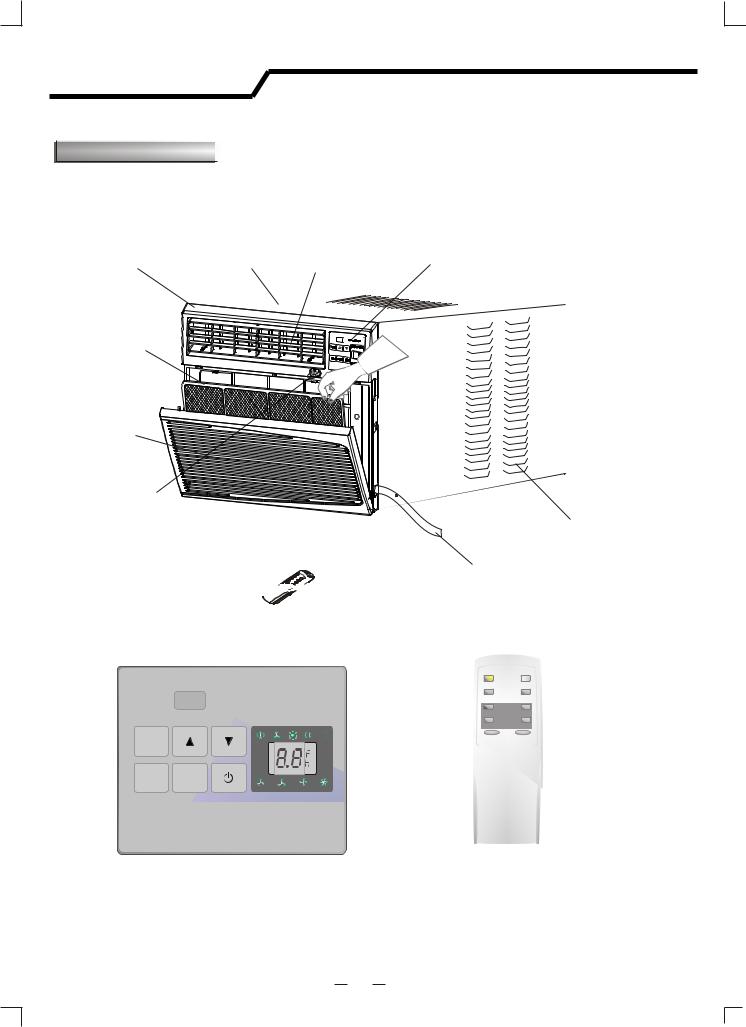
Introduction
Part Identification
 Remote control model
Remote control model
Front Panel |
Cabinet |
Air Outlet
Air Filter
Interior
Air Inlet
Grille
Fresh Air
Vent Lever
Remote Control 



Control Panel
Airconditioner
Timer
Fan
Mode
Speed
Control Panel
Exterior
Air Inlet
Power Cord
Remote Control
Power |
Timer |
Mode |
Power Saver |
Auto |
Mid |
|
Fan Speed |
High |
Low |
_ |
+ |
|
|
|
Temp/Time |
Note:
The figures in this manual are based on the external view of a standard model. Consequently, the shape may differ from that of the air conditioner you have selected.
3
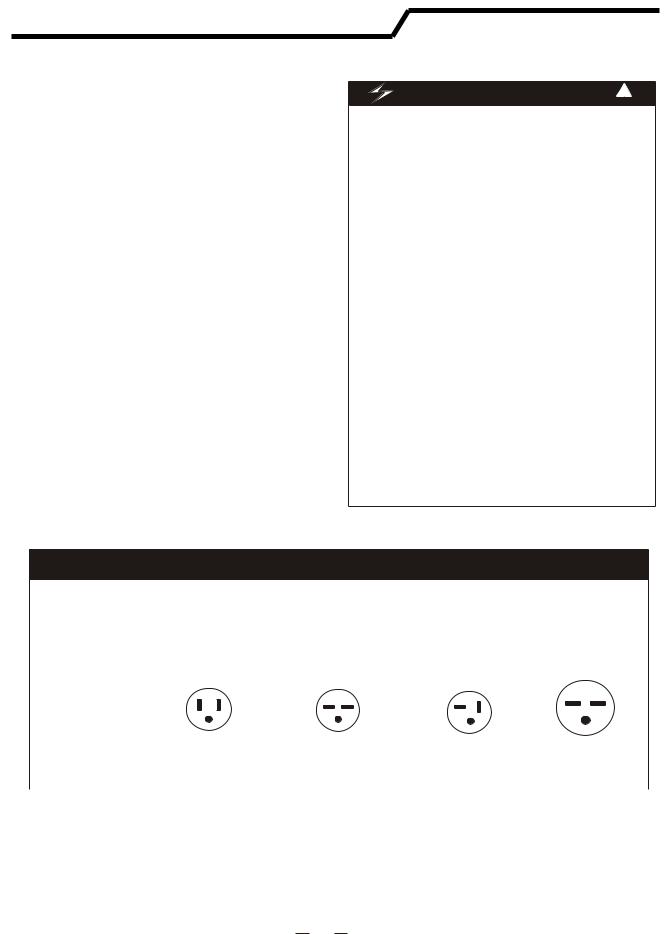
Electrical specifications
1.All wiring must comply with local and national electrical codes and must be installed by a licenced electrician. If you have any questions regarding the following instructions, contact a licenced electrician.
2.Check available power supply and resolve any wiring problems BEFORE installing and operating this unit.
3.For your safety and protection, this unit is grounded through the power cord when plugged into a matching wall outlet. If you are not sure whether your wall outlet is properly grounded, please consult a licenced electrician.
4.The wall outlet (3-pin) must match the plug
(3-pin) on the power cord supplied with the unit. DO NOT use plug adapters or extension cords.
See (Table 1) for receptacle and fuse information.
5. The rating plate on the unit contains electrical and other technical data. The rating plate is located on the right side of the unit. Make sure to use the correct power supply according to the rating plate of your air conditioner.
Electric Shock Hazard |
! |
If the air conditioner has a serial plate rating of 115 volts and up to and including 7.5 amps, the unit maybe on a fuse or circuit breaker with other devices. However, the maximum amps on all devices for that fuse or circuit breaker can not exceed the amps of the fuse for the circuit breaker.
If the air conditioner has a serial plate rating of 115 volts and greater than 7.5 amps it must have its own fuse or circuit breaker, and no other device or unit should be operated on the fuse or circuit breaker.
If the air conditioner has a serial plate rating of 230 volts, it must have its own fuse or circuit breaker, and no other device or unit should be operated on the fuse or circuit breaker.
To avoid the possibility of personal injury, disconnect power to the unit before installing or servicing.
RECEPTACLE AND FUSE TYPES
COOLING CAPACITY |
10K-12K |
18K(Cooling only) |
24K |
18K-24K |
|
(Cooling only) |
10K-12K(With heating) |
(Cooling only) |
(With heating) |
||
|
|||||
RATED VOLTS |
125 |
250 |
250 |
250 |
|
|
|
|
|
|
|
AMPS |
15 |
15 |
20 |
30 |
|
|
|||||
|
|
|
|
|
|
WALL OUTLET |
|
|
|
|
|
|
|
|
|
|
|
FUSE SIZE |
15 |
15 |
20 |
30 |
|
|
|||||
|
|
|
|
|
Table 1
Note:10K-12K(Cooling only) including models AAW-10CR1FHU AAW-10CM1FHU AAW-12CR1FHU AAW-12CM1FHU 18K(Cooling only) including models AAW-18CR3FHU AAW-18CM3FHU
10K-12K(With heating) including models AAW-10DR3FHU AAW-12DR3FHU 24K(Cooling only) including models AAW-24CR3FHU AAW-24CM3FHU 18K-24K(With heating) including models AAW-18DR3FHU AAW-24DR3FHU
4
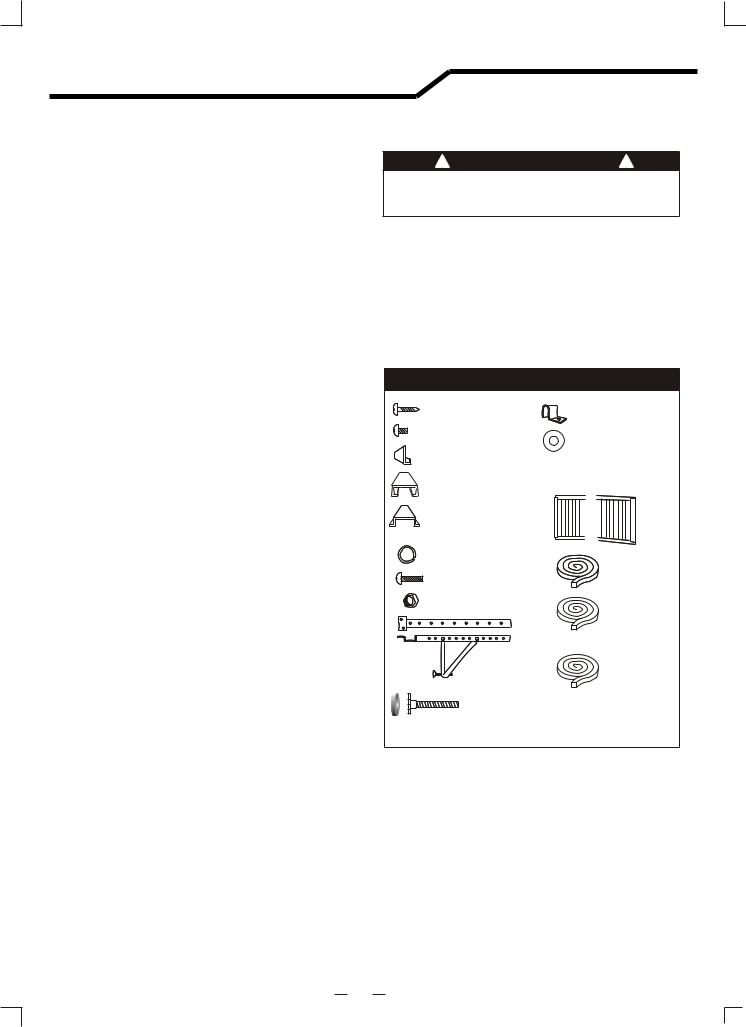
Tips before installation
Your Room Air Conditioner unit is designed to
be highly efficient and save energy. Follow these recommendations for greater efficiency.
1.Select thermostat setting that suits your comfort needs and leave the thermostat at that chosen setting.
2.The air filter is very efficient in removing airborne particles. Keep the air filter clean. Typically, the filter should be cleaned once a month. More
frequent cleaning may be necessary depending on outdoor and indoor air quality.
3.Use drapes, curtains, or shades to keep
direct sunlight from heating your room, but
DO NOT obstruct the air conditioner. Allow air to circulate around the unit without obstructions.
4. Start your air conditioner before outdoor air becomes hot/cold and uncomfortable. This avoids an initial period of discomfort while the unit is cooling or heating off the room.
5. When outdoor temperature is cool enough, use HIGH or LOW FAN
only. This circulates indoor air, providing some cooling comfort, and utilizes less electricity than when operating on a cooling setting.
Your Room Air Conditioner was designed
for easy installation in a single or double-hung window. NOTE: This unit is NOT designed for vertical (slider type) windows.
! CAUTION !
To avoid installation/operating difficulties, read the instructions thoroughly.
NOTE: Save the shipping carton and packing materials for future storage or transport of the unit. Please check the contents of the hardware kit against the corresponding model check list, prior to installation of the unit.
See lists below.(Fig.A)
Fig. 1A InstallationFig. A InstallationHardw re ModelHardware463AAC008BA
3/4"Screws (10) |
Shutter Clamp(2) |
|
|
||
1/4"Screws (23) |
Washer(10) |
|
Top Channel(1) |
||
Side Curtain RH(1) |
||
Bottom Channel(1) |
||
Side Curtain LH(1) |
||
(For 10K to 12K models) |
||
|
||
Bottom Channel(1) |
|
|
(For 18K to 24K models |
|
|
-Factory Installed) |
|
|
Lock Washers(4) |
|
|
1-1/2"x1/4 Bolts(4) |
Seal(1) |
|
|
||
1/4" Nuts(4) |
|
|
|
Foam (1) |
|
Mounting |
Double |
|
Brackets(2) |
||
Angle |
Adhering |
|
Brackets(2) |
Seal(1) |
|
End Cap & |
|
|
Leveling Legs(2) |
|
NOTE: Surplus screw(s) for spare use.
Tools Needed for Window Installation
Screw drivers: Both Philips and flat head Power drill: 1/8 inch diameter drill bit Pencil
Measuring tape Scissors Carpenters level
5
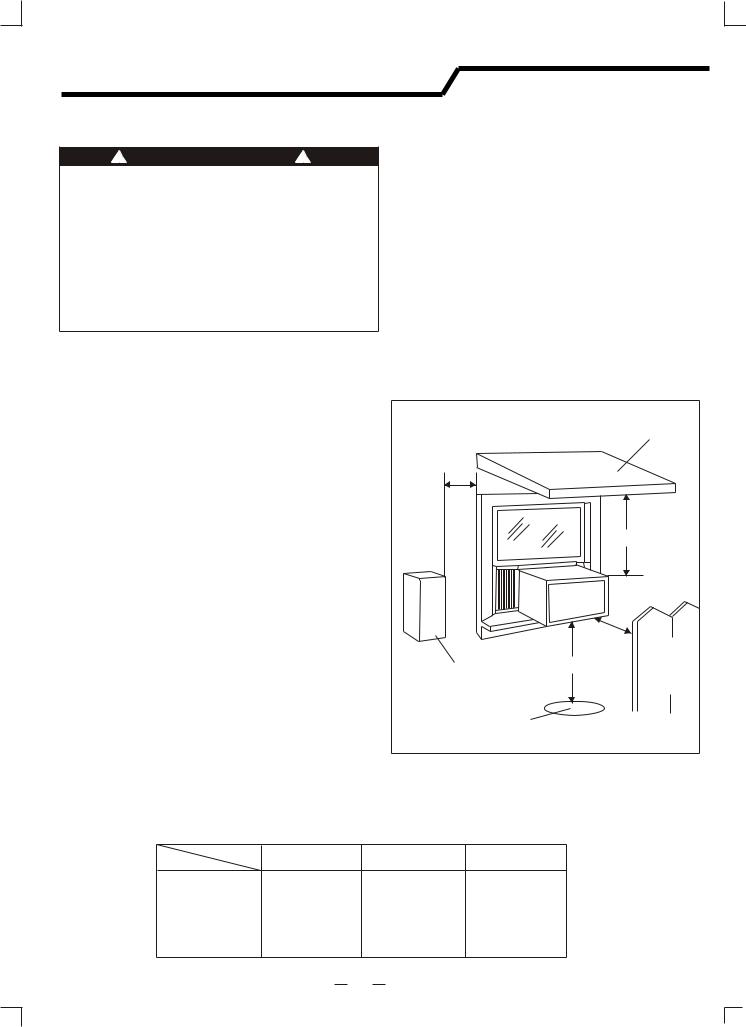
Installation instructions
!CAUTION !
Because the compressor is located on the controls side of the unit (right side), this side
will be heavier and more awkward to manipulate. Inadequate support on control side of the unit can result in personal injury and damage to your unit and property. Therefore, it is recommended
to have someone assist you during the installation of this unit.
1. Select the Best Location
E.Be certain the proper electrical outlet is within reach of the installation. Use only a single outlet circuit rated at proper current (see table 1 on page 4). All wiring should be in accordance with local and national electrical codes.
F.Your unit was designed to evaporate condensation under normal conditions. However, under extreme humidity conditions, excess condensation may cause the basepan to overflow to the outside.
The unit should be installed where condensation run-off cannot drip on pedestrians or neighboring properties.
A. Your room air conditioner was designed to |
|
|
|
||
fit easily into a single or double hung window. However, |
|
|
|
||
since window designs vary, it may be necessary to |
|
|
Awning |
||
make some modifications for safe and proper |
|
20" |
|
||
installation. |
|
|
|
|
|
|
|
|
Min. |
|
|
|
|
|
|
|
|
B. Make sure window and frame is structurally |
|
|
|
||
sound and free from dry and rotted wood. |
|
|
12" Min. |
||
|
|
|
|
|
|
C. For maximum efficiency, install the air conditioner |
|
|
|
||
on side of the house or building which favors more |
|
|
|
||
shade than sunlight. If the unit is in direct sunlight, |
|
|
20" |
||
it is advisable to provide an awning over the unit. |
|
|
|||
|
|
|
|
|
Min. |
D. Provide sufficient clearance around the cabinet |
|
|
Fence, |
||
to allow for ample air circulation through the unit. |
|
30" Min. |
wall, or |
||
|
other |
||||
See (Fig.B). The rear of the unit should be outdoors |
|
Side |
|||
|
obstruction |
obstacle. |
|||
and not in a garage nor inside of a building. |
|
|
|
||
Keep unit as far away as possible from obstacles and |
|
Ground |
|
||
obstructions and at least 30" above the floor or |
|
|
|||
|
|
|
|||
ground. Curtains and other objects within a room |
|
Fig.B |
|
||
should be prevented from blocking the air flow. |
|
|
|||
Window opening requirements |
|
|
|
||
(see table below) |
|
|
|
|
|
Size |
Model |
10K |
12K |
18-24K |
|
Cabinet size |
20.5" *14.8" *23.1" 22.8" *15.7" *24.1" 26.5" *18.5" *26.9" |
|||
(W*H*D) |
||||
|
|
|
||
Min. Window |
24" |
27" |
30" |
|
opening |
||||
|
|
|
||
Max. Window |
38" |
41" |
44" |
|
opening |
||||
|
|
|
||
6
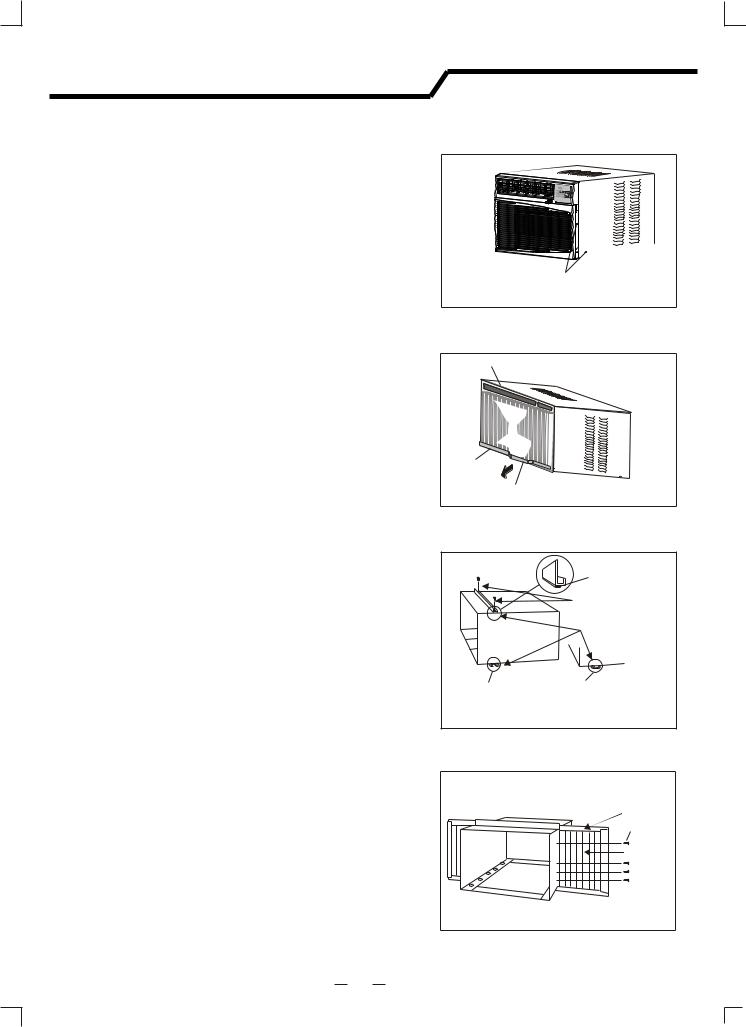
Installation instructions
2. Preparation to Remove the
Air Conditioner Slide-Out Chassis
A.Remove total of (4) Philips screws securing the chassis to the cabinet. There are (2) screws on each side. The set of screws closest to the front of the unit secure the front panel to the cabinet. The set of screw closest to the rear of the unit secure the cabinet to the chassis.
See (Fig. 1).
B.Remove the front panel assembly from the cabinet by gently pulling it.
C.Grasp the pull handle at the front of the slide-out chassis and carefully slide the
air conditioner out of the cabinet. See (Fig. 2).
Please seek assistance for this procedure.
NOTE: Screws must be reinstalled upon completion of the window installation to secure slide-out chassis.
3. Assembly of the upper & lower channels to the cabinet
A." L" Shaped Top Channel: Stick the double adhering seal to the " L" shaped top channel, and then Install the "L" shaped top channel to the cabinet as shown in (Fig. 3) using (5) 1/4" screws.
B."n" Shaped Bottom Channel installed as shown in (Fig. 3)using (4) 1/4" screws.
NOTE: For 18K to 24K models, the bottom channel has been factory-installed, and their shapes may differ from the others, but their functions are similar.
4. Assembly of the side shutters (curtains) to the cabinet.
Slide the shutters into the top and bottom channels as shown in (Fig. 4). The shutters are identified (on each frame) as "left" & "right". Attach the shutters to the cabinet using (4) 1/4" screws on each side.
Right side
Philips screws
Fig. 1
Coil
Chassis
Pull Handle
|
Fig. 2 |
|
Double |
|
Adhering seal |
|
1/4" Screw |
|
Channel |
For 10K to 12K models |
For 18K to 24K models, |
|
( Factory-Installed) |
Fig. 3
Shutter Frame |
1/4" screw |
Right Shutter |
Fig. 4
7
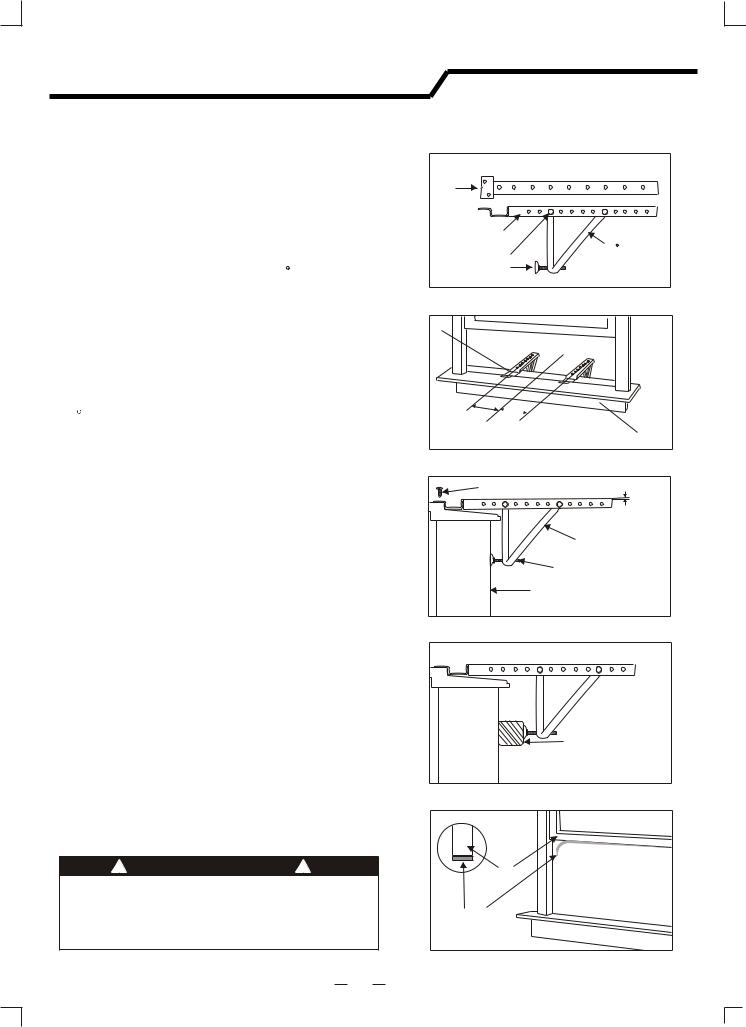
Installation instructions
5. Installation of Mounting Brackets and
First Sealing Strip
NOTE: Windows come in a variety of different styles. Therefore, it may be necessary to modify or improve your particular installation.
A. Attach the bracket assembly to 90 angle support brackets (Fig. 5) using (2) 1 1/2" bolts
Two bolts per bracket. Secure with the (2)
1/4" lock washers and (2) 1/4"nuts. DO NOT immediately tighten these bolts as it may be necessary to adjust the depth of the bracket assembly, depending on the depth of your window sill. See (Fig. 7).Install the two leveling screws into the 90 support brackets. Test the bracket assembly in the window before cabinet installation. If the leveling screws are distanced too far away from the wall to provide stability, it may be necessary for you to fill
this area with a solid piece of wood. See (Fig. 8).
B.Measure the inside window sill width and find the center as shown in (Fig. 6). Align the V-slot in each bracket on these marks and mount the brackets to the sill using 3/4" screws provided. Brackets should be perpendicular to the inside window sill. See (Fig. 6).
C.For proper condensation run-off it will be necessary to adjust the angle/pitch of the window brackets. This is accomplished by adjusting the distance of the leveling screw on the outer wall. The maximum angle/pitch should not exceed more than 3/16". See (Fig.7).
D.Cut the seal strip to fit the underside of the bottom
window sash. Remove the peel-off backing on the seal and attach it to this sash. See (Fig. 9).
! CAUTION !
Use a solid piece of wood to provide stability. This will be required when sills are extra deep.
See (Fig. 8).
(TOP VIEW) |
|
V-slot |
|
Bracket Assembly |
|
|
90 Angle |
Bracket Bolts |
Support Brackets |
Leveling Screw |
|
Fig. 5
V-slot
Center
9.6" 9.6"
10.3"
10.3"
12.6"  12.6"
12.6"
Measurement for Model 10K =9.6"
Measurement for Model 12K = 10.3" Window sill Measurement for Model 18K to 24K = 12.6"
Fig. 6
(2) 3/4" screws per bracket |
3/16" Maximum |
Bracket Assembly |
Leveling Screw |
Outer Wall Construction |
Fig. 7
Solid Piece Wood |
(If required) |
Fig. 8
Window Sash |
Window Sash |
Sealing Strip |
Fig. 9
8
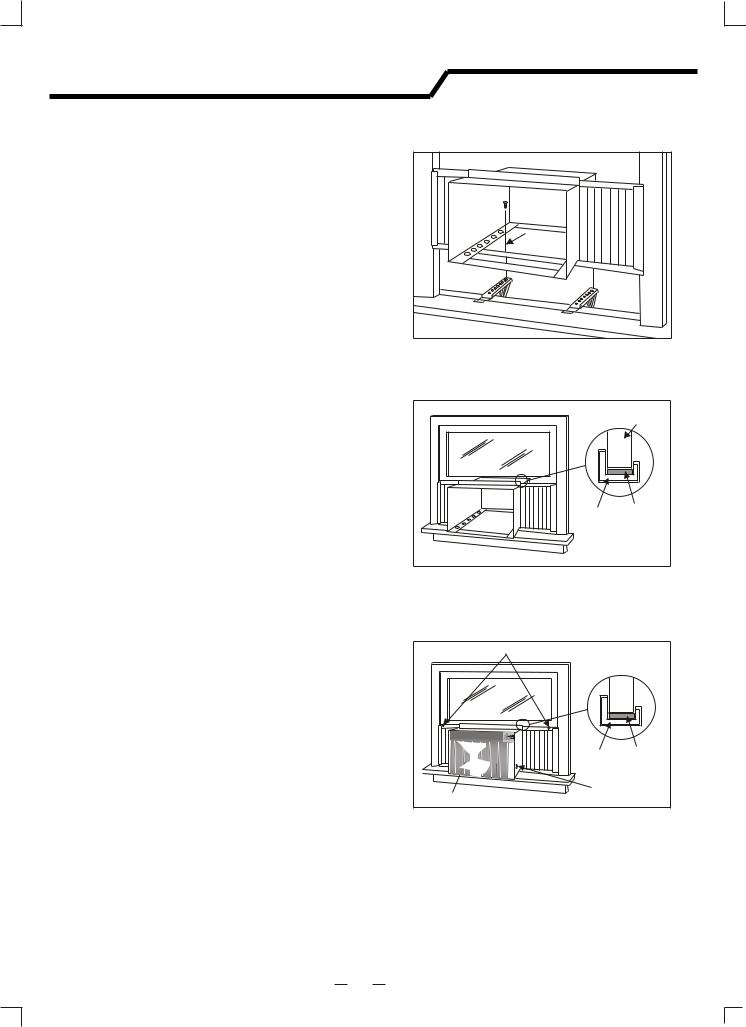
Installation instructions
6.Installation of the cabinet
A.Align one hole in the bottom of the cabinet with one hole in the bracket assembly. Secure the cabinet to the bracket using (3) 1/4" screws provided. Repeat the same procedure on the opposite side of the cabinet. See (Fig. 10).
B.Ensure the "L" shaped mounting channel is positioned in front of the sash. The bottom channel of the cabinet should be positioned in the track provided on the bracket assembly. Pull the window down until it rests just behind the front of the "L" shaped mounting channel. See (Fig. 11).
C.Check to make sure that the cabinet is slanted slightly downward on the outside. If necessary, re-adjust support bracket as shown in (Fig. 7).
7.Secure Shutters
A.Carefully slide the air conditioner back into the cabinet.(Please seek assistance for this procedure).
B.Reinstall the slide-out-chassis security screws (removed earlier) on both sides of the cabinet. See (Fig. 12).
Secure the top of the frames to the window sash with
(2) 3/4" screws.
C. Now, secure bottom frame of shutters using one shutter clamp and one 3/4" screw on each side(Fig. 12).
8.Reinstalling Front Panel Assembly
A.Position the front panel on the cabinet starting at the top. The front panel lock tabs must be inserted into the retaining slots in the cabinet. Repeat this procedure on all sides.
B.Secure the front grille to the cabinet using the Philips screws removed earlier(Fig. 1).
1/4" Screws |
Fig. 10
Window Sash |
|
"L"Shaped |
Seal |
|
|
Mounting |
|
Channel |
|
Fig. 11
3/4" screws |
|
"L"Shaped |
Seal |
Mounting |
|
Channel |
|
Security Screw |
|
Coil |
|
Fig. 12
9

Installation instructions
9.Complete the installation
A.Cut the foam to fit the opening between the top of the inside and outside window. See (Fig. 13).
B.Some installations may require additional sealing around the window and air conditioner. Check for any air leaks and seal where necessary.
C.In very humid areas, the water removal may be excessive enough to overflow the unit or increase the noise of the air conditioner. If this occurs, you may wish to attach a drain hose (not included) to the drain plug allowing condensations to run off conveniently.
See (Fig. 14).
Foam
Fig. 13
 Drain Hose
Drain Hose
(not included)
Fig. 14
10
